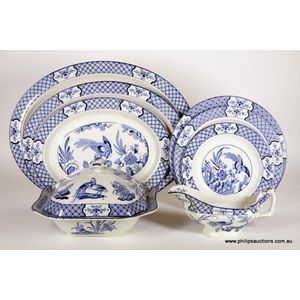Ridgway & Coalport Trios: Mazarin Blue & Phoenix Pattern
You must be a subscriber, and be logged in to view price and dealer details.
Subscribe Now to view actual auction price for this item
When you subscribe, you have the option of setting the currency in which to display prices to $Au, $US, $NZ or Stg.
- Bone China - Bone china, Also called 'English china", is one of the three types of porcelain, the other two being soft paste porcelain and hard paste porcelain.
Porcelain is an ancient ceramic material, first made in China, hence the common name "china", and the introduction of bone china was to counter the imports of Chinese porcelain.
The initial development of bone china is credited to Josiah Spode, who introduced it around 1800 and it was soon after copied by other manufacturers including Minton, Coalport, Davenport, Derby, Worcester, Wedgwood and Rockingham and the Herculaneum factory at Liverpool.
Spode's bone china was made by mixing ash from cattle bones with feldspar and kaolin, which created a material that was stronger, more translucent, and whiter than traditional porcelain. He began to produce this new type of porcelain in 1796 and it quickly became very popular.
At the time, the process and ingredients were kept secret and were only known to a few manufacturers and were protected by patents.
In the 19th century, bone china became increasingly popular and was widely produced by many manufacturers in England. During this time, it was considered a luxury item and was often used to create fine dining sets and other decorative items.
Bone china is still used in the production of fine porcelain wares, such as tea sets, figurines, and other decorative pieces. His basic formula of six parts bone ash, four parts china stone, and three and a half parts china clay remains the standard English body. It is still considered a luxury item due to its strength, translucency, and whiteness, and is often used for high-end and high-quality porcelain. China. - Mazarin Blue - Mazarin blue, also known as bleu de Mazarin, is a shade of blue named after Cardinal Mazarin, a prominent French statesman and Catholic cardinal who lived in the 17th century. The color is a deep, rich blue with a hint of purple, and it was popular in France during the Baroque period.
This item has been included into following indexes:
- Coalport and Coalbrookdale porcelain (England) - ceramics 518
- Coalport porcelain (England), item type
Visually similar items

One New Hall Trio and a New Hall cup & saucer, one pattern 1681 & 1865, circa 1810, both London shape

A twenty three piece part Wood & Sons dinner service, 1916, in 'Yuan' pattern, comprising five large plates, six entree and six side plates, a tureen, dish, three oval platters and a sauce boat, all in a blue and white Chinoiserie pattern; backstamps under

A mixed group of Royal Crown Derby Imari table wares 1884, 1906, early 1970s, 'Traditional Imari' pattern 2541 and 'Old Imari Japan' pattern 1128, and other, comprising two Victorian Imari saucers, a pair of plates and a scalloped dish and small beaker in

Pair of silver plate on copper wine coasters each 18 cm diameter (2)
